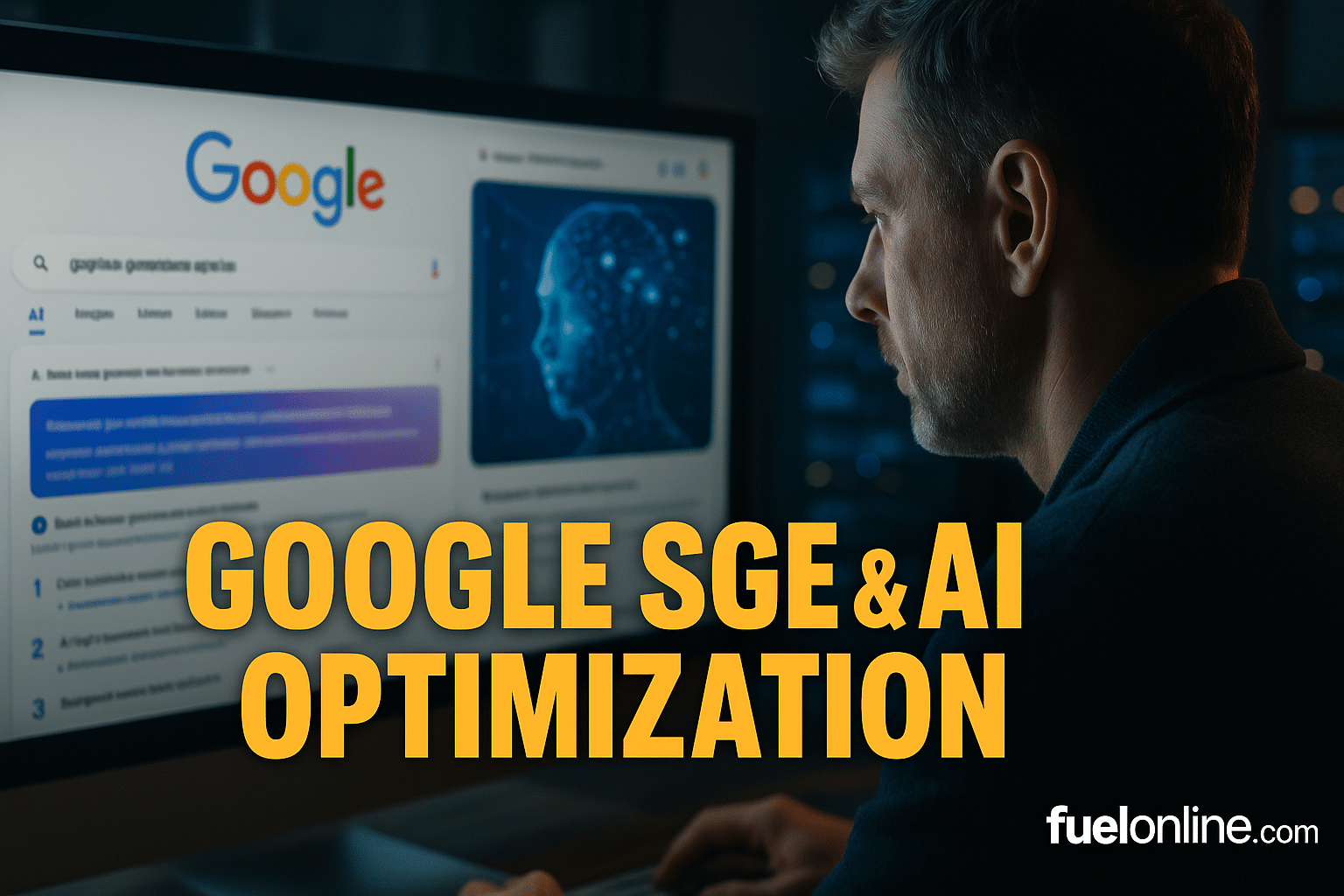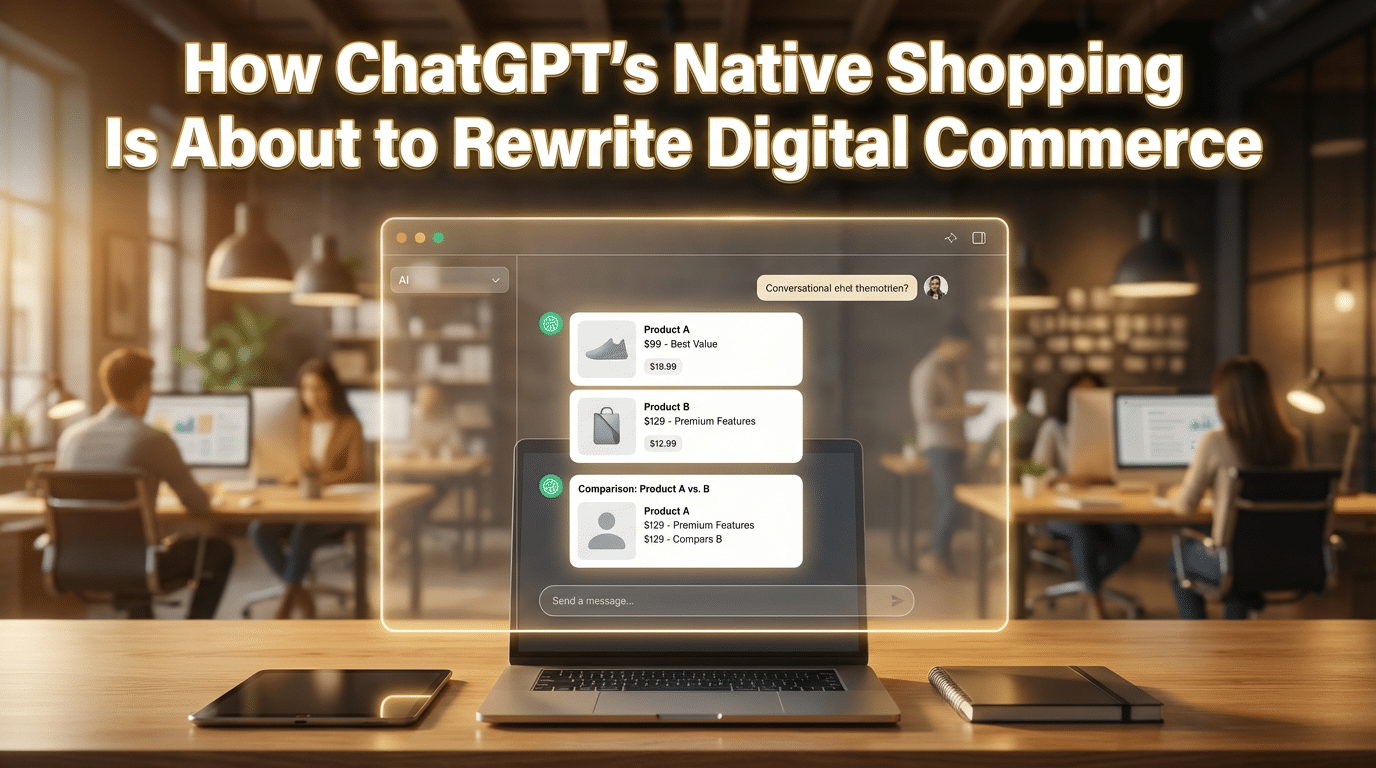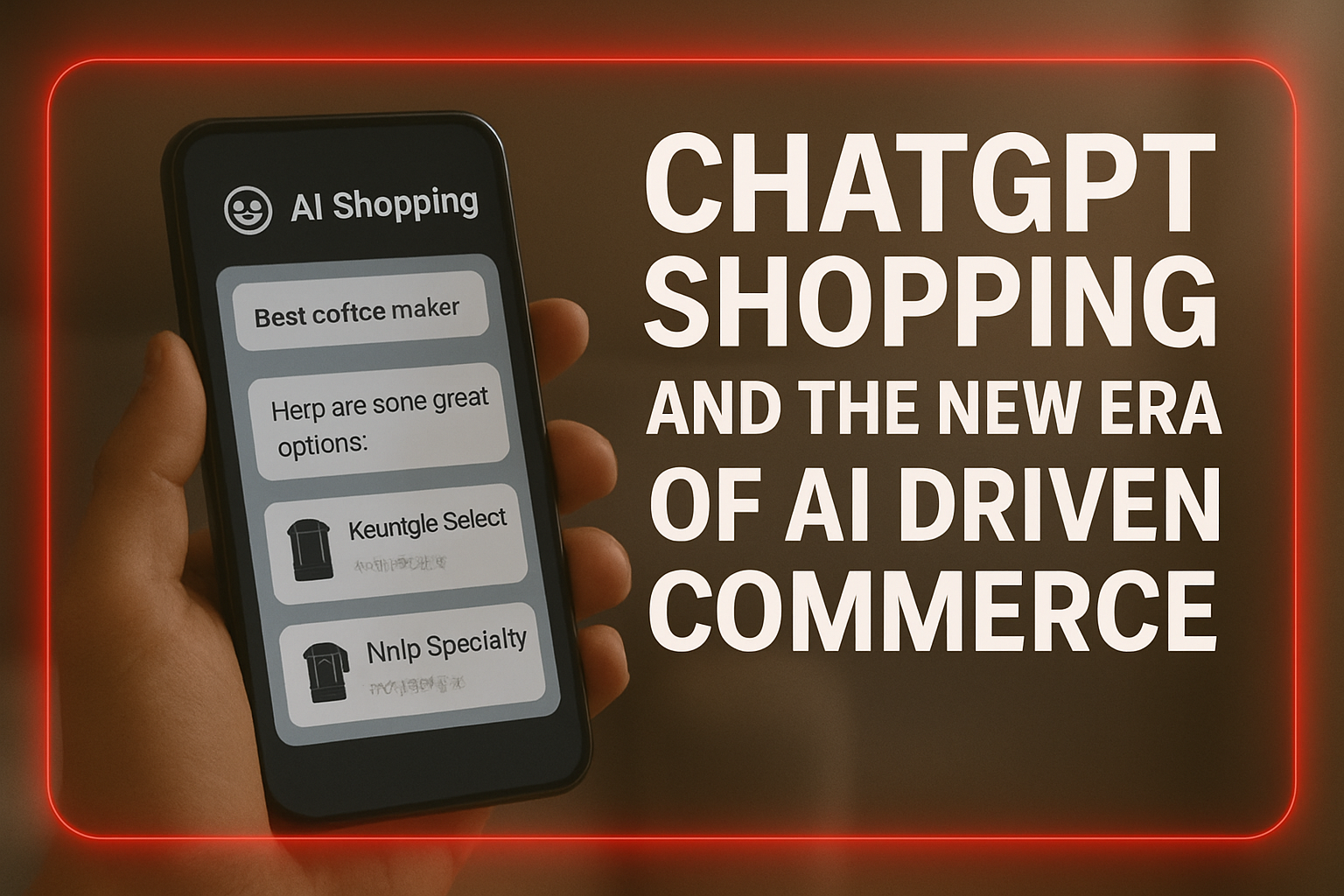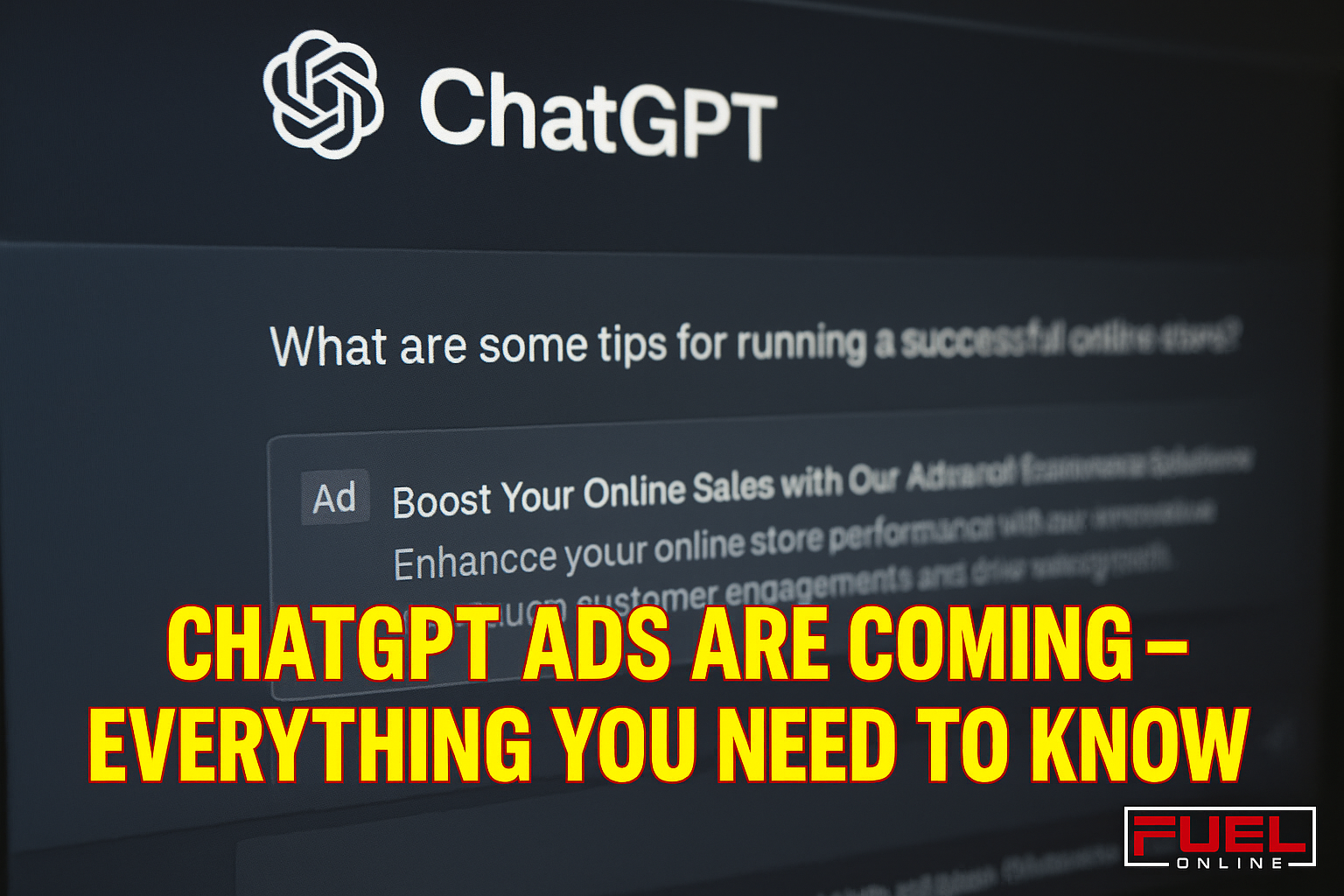Ai SEO
Search is undergoing a transformation. Google’s Search Generative Experience (SGE) is changing how people find information by integrating AI-generated answers directly into search results. Instead of simply showing a list of blue links, Google can now generate a rich answer at the top of the results page – effectively creating new content from your web pages. This shift has profound implications for search engine optimization (SEO) and digital marketing. In this comprehensive guide, we’ll explain what SGE is, how it works, why it matters, and exactly what you can do to optimize your site for this new AI-driven search landscape. We’ll focus on Google (by far the market leader) while also touching on Microsoft Bing’s similar AI search efforts. By the end, you’ll understand every aspect of Google’s SGE and the emerging “AI optimization layer” – and how to position your content for success in AI-powered search results. If you want to know How to optimize for AI search results and Google SGE or How to optimize content for generative AI? This is the guide for you,
What is Google SGE (Search Generative Experience)?
Google SGE is an experimental AI-powered search mode that Google introduced in 2023. It uses generative artificial intelligence – the same kind of technology behind ChatGPT – to answer search queries with new, synthesized content right on the results page. In other words, Google’s algorithms will read information from across the web and compose an AI-generated summary or answer for your query, displayed at the top of the search results. This AI answer is often accompanied by citations or links to the sources it drew from, and it can include images, bullet points, or other enriched elements.
Originally launched in Search Labs (Google’s testing program) under the name “SGE,” the feature has since been rolled into Google’s mainstream search (in certain regions) as of 2024 under the label “AI Overviews.” If you perform a Google search on a supported account, you may see an “AI snapshot” or overview at the top of the results. For example, a query like “best time to visit Paris” might yield an AI-generated paragraph summarizing the ideal travel seasons, followed by a few source links. Users can then enter a conversational mode (like a chat) to ask follow-up questions or clarify the answer, all within Google’s interface.
In practical terms, SGE turns Google Search into a more interactive, AI-driven experience. Users receive quick answers to complex questions, synthesized from multiple web sources. They can refine their query by asking follow-ups (“What about in winter?”) and get context-aware responses from the AI. Google is essentially leveraging its advanced large language models (such as BERT, MUM, and the newer PaLM/Gemini models) to better understand natural language queries and generate human-like answers on the fly. This goes beyond the traditional featured snippet (which was just an exact excerpt from one page). SGE’s answers are original compositions: the AI might combine facts from a government site, an example from a blog, and a definition from Wikipedia into one cohesive response.
It’s important to note that SGE doesn’t trigger for every search. Google determines which queries are suitable for an AI-generated result. Generally, informational and question-based searches are most likely to get an AI overview. Simpler or factual queries might still rely on standard results or the older direct answer boxes. For instance, “coffee shop near me” may show a regular map pack (local results) without an AI summary, whereas “how to make cold brew coffee” could prompt an AI step-by-step summary. Early analyses indicated that long-tail, multi-word queries and those phrased as natural language questions have a higher chance of triggering SGE. Google has also been cautious with sensitive “Your Money, Your Life” topics (like medical or financial advice), ensuring the AI doesn’t provide improper guidance – so those might not always show AI answers, or the answers may come with disclaimers. SGE is still evolving, but as of mid-2024 it appeared in a large portion of searches (some studies observed AI overviews on roughly 45–60% of informational queries).
In summary, Google SGE is Google’s next-generation search interface that uses AI to deliver answers. It represents Google’s answer to the rise of AI chatbots in search and is a pivotal shift from the classic search experience. Next, let’s explore why this change is so significant for marketers and site owners.
Why SGE Matters: How AI Answers Are Changing Search Behavior
The advent of AI-generated results is a game-changer for SEO and user behavior. With SGE’s answers sitting “above the fold” (at the very top of the results page), users can get what they need without scrolling or clicking as much as before. This has introduced the concept of “Position Zero” – the AI’s answer box that comes even before the #1 organic result. For businesses that rely on search traffic, this new position zero can be both an opportunity and a threat.
From the user’s perspective, SGE makes search faster and more convenient. People can ask Google a question and instantly see a summary of key information, rather than having to click through multiple sites. It’s akin to asking a knowledgeable assistant for the highlights. Users can refine their searches in a conversational way, which feels intuitive. In fact, Google reported that when AI overviews are present, overall search engagement increases – people tend to try more follow-up queries because the experience encourages exploration. It’s as if search has become a two-way dialogue rather than a one-and-done query.
However, the flip side is that fewer users may click through to actual websites. Numerous studies and early data have shown a sharp rise in zero-click searches (where the user doesn’t click any result because the answer was given on Google’s page). By one analysis, as much as 60% of searches now end without a click when an AI overview is present, a significantly higher zero-click rate than before. Even when users do scroll past the AI summary, the click-through rate (CTR) on traditional results is dropping. For example, one study found that the presence of an AI overview caused a 34% drop in clicks on the #1 organic result, compared to the same query without an AI box. Overall, sites that used to get a lot of traffic from informational queries are seeing noticeable declines – some reports talk about 20–50% drops in organic traffic for content that is now being answered directly by Google’s AI. This is a major shift in the SEO landscape: even if your rankings stay the same, your traffic can shrink if Google answers the query instead of sending users to you.
For marketers and executives, this trend raises important questions. If Google’s AI is “crafting new content” based on our websites, what does that mean for our brand and messaging? One concern is that Google’s AI might form its own perception of your brand or product. For instance, if multiple sources the AI reads have mixed opinions about a product, the AI’s summary might present pros and cons that influence user perception before they ever click your site. In essence, Google becomes an intermediary voice describing your brand. This makes it critical to ensure that positive, accurate information about your company is prevalent online (so the AI picks that up). On the flip side, being featured in an AI overview can be a credibility boon: your brand name appearing as a cited source at the top can signal trustworthiness to users. It’s prime real estate for brand visibility – even if the user doesn’t click through, they see your name associated with the answer, which can build awareness and trust.
Google’s own guidance has been that there’s “nothing special” content creators need to do for SGE beyond continuing to produce helpful, people-first content (following Google’s Search Essentials guidelines). In theory, the same factors that made you rank well – quality, relevance, authority – will make you a candidate for AI summaries. But in practice, SGE adds another layer of competition and complexity. Not only do you want to rank high; now you also want to be one of the sources the AI chooses to quote or summarize. And since the AI often only cites a handful of sources (Google’s AI Overviews typically reference about 3–8 sources, even for long answers), missing out on those citations could mean significantly less visibility.
There’s also a monetization aspect to consider. Google isn’t altruistically giving answers – they are still a business and have begun incorporating ads into AI overviews as well. For example, in late 2024 Google started testing sponsored ads within the AI answer box (blended in with the AI content). An example might be a query about cleaning leather couches where the AI overview gives some tips and also embeds a sponsored product ad for a leather cleaning kit. This indicates Google’s intent to keep users on the search page longer (since they can serve ads there) rather than sending them off to other websites immediately. For SEO professionals, this underscores that Google’s interests are not necessarily aligned with ours – we want clicks to our sites, Google wants to satisfy the query (and sometimes monetize it) without a click.
In short, SGE is important because it fundamentally alters how users interact with search results. It can reduce traffic to sites and change how brands are presented. SEO strategy must adapt to this new reality where getting to the top 10 is no longer the only goal; now the goal is to be included in the AI-generated answer. To do that, we need to understand how Google’s AI selects and composes those answers.
How Google’s Generative AI Search Works (in a Nutshell)
To optimize for SGE, it helps to know how it actually generates answers. At a high level, Google’s generative search uses a technique known as retrieval-augmented generation. When you enter a query, Google still runs its usual search algorithms under the hood to find relevant pages (using all its ranking signals like keywords, freshness, links, etc.). But instead of just showing you those top results, the SGE system takes the top few relevant pages and feeds portions of their content into a large language model (LLM). This LLM – a powerful AI trained on vast amounts of text – then synthesizes an answer by drawing on information from those pages (and possibly from Google’s knowledge graph or other databases for factual support).
In simpler terms, the AI is reading your web pages and writing its own summary. It might take a definition from one site, an example or statistic from another, and combine them into a cohesive paragraph. The output is not a direct copy-paste from any single source (in fact, studies show the AI overview rarely quotes text verbatim – it typically paraphrases and combines information, with less than ~6% of AI answers containing the exact query or exact text from a source). Google then displays this output at the top of the results, usually with little footnote numbers or icons that, when clicked, reveal which source each piece of information came from. Those source links are often shown to the right or below the AI text.
Crucially, Google’s system places heavy emphasis on relevance and credibility when choosing sources to feed into the AI. Early observations suggested that SGE often pulled from the top 1–3 organic search results for that query (which makes sense – those are what Google’s normal ranking system deemed the best answers). In fact, being in the top couple of results was initially seen as a strong prerequisite to be included in the AI answer. Google’s experiments indicated that if your page is not on page one, it’s much less likely to be used by the AI. That said, the AI can also incorporate other sources if they add unique value. A large-scale study by SurferSEO in late 2024 found that about 52% of the sources cited by AI overviews were pages that ranked in the top 10 for the query – meaning roughly half the time, the AI might reach beyond the top ten results to grab additional relevant info. This implies that even content not ranking #1 can still be featured in an AI answer if it addresses the query especially well or covers a niche angle that the top results didn’t. In some cases (particularly very specific questions), the AI has even pulled in sources from deeper in the index, or from sites specializing in that topic, despite those not being high-ranked overall.
What does Google’s AI “look for” in content? From the patterns we’ve seen, a few things stand out:
-
Clear, concise answers: The AI prefers content that directly answers the question. If your page has a paragraph that plainly says “The strongest bone in the human body is the femur, which can support up to X times your body weight,” that snippet is very likely to be scooped up for an overview about strongest bones. On the other hand, if the answer is buried in fluff or not stated outright, the AI might skip it. Often, pages that have a FAQ section or a sentence that explicitly answers the question (like a definition or a bolded statement) get used.
-
Structured information: The format of your content matters. AI-generated answers frequently include bullet points or numbered lists when appropriate. In fact, around 70–80% of AI overviews contain some form of list (unordered or ordered), because lists are an easy way to convey steps, tips, or a summary of options. If your content is already structured as a step-by-step list or key point list, it’s very “AI-friendly.” Similarly, clearly labeled sections (with descriptive headings) help the AI understand the content. For instance, if you have an
<h2>that says “How to Bake a Cake – Step by Step” followed by steps 1, 2, 3, the AI can recognize that and might use it to form a concise step list answer. -
Relevant context and keywords: Google’s AI has a strong grasp of natural language and synonyms (thanks to models like BERT, it understands context, not just exact keywords). It will rewrite things in a way that may not use the exact query words. This means your content can be used even if it doesn’t literally match the query, as long as it’s contextually answering it. However, having the question phrased in your content (like “How do you do X?” followed by the answer) can make it very obvious to the AI what part of your page is relevant.
-
Authority and accuracy: While the AI isn’t perfect at judging truth, Google does try to ground the answers in trusted sources. Pages that demonstrate expertise, authoritativeness, and trustworthiness (E-E-A-T) have an edge. This could mean content on well-known sites, content by credentialed authors, or simply content that has facts supported by evidence. Google has even updated some of its crawling guidelines to let publishers opt-out of being used in AI summaries via special meta tags – an indicator that they are aware of publisher concerns around content misuse. But generally, if your site has a reputation for quality content in a subject, the AI is more likely to pull from it. On the flip side, user-generated content (like forums or random comments) are rarely used in AI answers – one study noted less than 1% of AI overviews included any user-generated source like a forum. Google seems to favor editorial content and reference sources over, say, a Reddit thread (even if that thread might have the answer).
-
Freshness when relevant: For topics where information changes rapidly (e.g., technology updates, current events), the AI will prefer up-to-date sources. Google’s index is updated frequently, and its AI can retrieve recent content. Ensuring your content is updated (or having a recent date) can help if the query needs current data. For example, a query like “market trends in 2024” will likely use sources from 2024, not an article from 2019.
The output of the AI is typically around a few hundred words at most – studies found AI overview snippets average about 150–200 words initially (with longer answers if you click “Show more”). Because of this brevity, the AI often cherry-picks only the most relevant nuggets from each source. It might use one sentence from your page that perfectly addresses one aspect of the question, and another sentence from another page for another aspect. If your page alone comprehensively answers everything, it could potentially be the sole or primary source, but Google seems to like providing a “well-rounded” answer by combining sources. It’s not uncommon to see an overview cite 3–5 different websites for different facts or points. Each source usually only gets referenced once (the AI won’t typically cite the same page multiple times in one answer).
Now that we understand how Google’s AI search works, the next question is obvious: How do we ensure our site is one of those sources chosen by the AI? The answer lies in a new approach to SEO – what some are calling the “AI optimization layer” on top of traditional SEO. Let’s dive into concrete strategies for that.
Optimizing Your Website for Google’s AI Results (SGE)
Optimizing for SGE means optimizing both for traditional rankings and for inclusion in AI-generated answers. Essentially, you need to keep doing all the good SEO practices you were doing, but also tailor your content and structure to be AI-friendly. Here are the key strategies and best practices:
1. Focus on Comprehensive, Question-Based Content
Identify the questions your target audience is asking in your domain, and create content that thoroughly answers those questions. In the era of AI search, informational depth is crucial. Websites that demonstrate depth and expertise on a specific topic are more likely to be chosen as sources for AI answers. This is because Google’s AI wants to give a complete and helpful answer – it tends to favor pages that cover the topic from multiple angles or provide added insights (so the AI can pull various bits from that one page).
Start by doing keyword research with an emphasis on natural language queries and long-tail keywords. For example, instead of targeting a head term like “email marketing,” you’d benefit from addressing queries like “How to improve email marketing open rates” or “best days to send marketing emails.” These longer, specific queries are precisely where AI overviews often appear. Once you have the questions, structure your content to answer them directly. A great approach is to use the question as a headline or subheadline (e.g., an H2 that says “How can you improve email open rates?”) and then immediately provide a concise answer below it. Think of the inverted pyramid style of writing: state the most important answer first, then elaborate with details and nuances in subsequent paragraphs. This way, if Google’s AI skims your page, it can quickly grab that direct answer and still have the option to include more detail from your elaboration if needed.
It’s also wise to incorporate a FAQ section on key pages or create dedicated Q&A pages. FAQ schema (more on schema later) can highlight to Google exactly what question you’re answering in each snippet of content. For instance, if you run a travel site, a blog post titled “What to Pack for a Week in Europe” could end with a FAQ: “Q: Do I need travel adapters in Europe? A: Most European countries use Type C or F plugs, so you’ll need an adapter…”. These bite-sized Q&As are perfect fodder for AI answers.
Remember, be thorough. Cover different sub-questions or related issues around a topic. If the main topic is broad, consider breaking it into a cluster of content pieces (pillar page + cluster pages model). That not only helps human readers but also positions your site as a go-to resource hub that an AI might lean on. For example, a pillar page on “Ultimate Guide to Canonical Tags” might link to sub-articles on “How canonical tags affect SEO,” “Canonical vs. 301 redirect,” etc. This cluster approach signals depth, and if Google’s AI is aware (via internal links and context) that your site has a cluster of expert content, it could boost your credibility as a source.
2. Provide Direct Answers and Definitions Up Front
When writing content, don’t bury the lede. Google’s AI often grabs the first relevant snippet it finds. Make sure that in the opening paragraphs of your article (or immediately after a heading that poses a question), you give a direct answer or definition. For example, if your article is “What are PFAS chemicals?”, your first line might be: “PFAS (per- and polyfluoroalkyl substances) are a family of man-made chemicals known for their durability and water-resistant properties.” That clear definition at the very top increases the chance that Google will use your content to answer that exact query. After providing the direct answer or definition, you can then go into more detail, context, and supporting information.
This style of front-loading the answer aligns with how users prefer to get information (immediately) and how AI summaries operate. Think of writing content in a way that could stand alone as a concise excerpt. If you can extract a sentence or two from your page and it answers a common question perfectly, you’re on the right track.
Additionally, use straightforward language for these key sentences. The AI will paraphrase, but if your language is too convoluted, it might skip to a clearer source. Aim for sentences that are easy to parse. For instance, rather than a flowery, complex sentence, use something a 9th-grader could easily understand. Clarity trumps cleverness here.
3. Use Structured Formatting (Headings, Lists, Tables)
As mentioned, formatting your content for easy digestion is critical. Break up your content with descriptive headings for each subsection. When appropriate, use bullet point lists or numbered steps to outline processes, tips, or lists of items. For example, an article titled “10 Tips for Safe Hiking” should actually list those 10 tips in bullet or numbered form. Not only is this good for human readers, but Google’s AI loves lists – it can easily turn them into a nice formatted answer (“Here are 5 tips: …”) without much effort.
Some statistics from research: a large majority of AI overview answers include at least one list format. Lists are common because they are inherently concise and scannable. If your content is one big wall of text or a very narrative essay, consider adding summary boxes or breaking key points into lists.
Tables can also be useful if you are comparing data or providing a reference (like a table of dimensions, prices, etc.). Google’s AI can read tables and might use them if the query is looking for a comparison. But at the very least, tables often get picked up in featured snippets – which can indirectly feed the AI.
Using proper HTML heading levels (H1, H2, H3, etc.) hierarchically is important. Don’t just style text to look big – actually use headings. The reason is that the AI likely uses the document structure to understand context. An <h2> that says “Ingredients” followed by a list tells the AI “this section is about ingredients.” An <h3> under that that says “For 4 servings” further refines context. This structural clarity helps the AI assemble relevant info and also possibly display an outline in its answer.
In short, format is king for AI optimization. Think in terms of snippets: could a certain section of your page be lifted out as a self-contained answer or list? If yes, format it clearly and label it with a heading.
4. Implement Schema Markup and Structured Data
Schema markup (structured data in JSON-LD or microdata format) is like food for AI. It translates your content into a machine-readable form. By adding schema, you help Google’s algorithms better understand the context and meaning of your content, which can be especially useful for an AI that’s deciding what to present.
At minimum, you should use basic schema types relevant to your content. For example: use Article schema for blog posts, Recipe schema for recipes, Product schema for product pages, FAQPage schema for pages with FAQs, and HowTo schema for instructional content. These schemas provide explicit information like the question and accepted answer in an FAQ, or the step-by-step structure of a HowTo with tools and duration, etc. Google’s AI overview can directly leverage this. For instance, if you have a FAQ schema that matches a user’s question, it’s almost like gift-wrapping the Q&A for Google to display.
One specific tip some SEO experts are trying is the “Mentions” schema property. This allows you to indicate that your article mentions a specific entity (e.g., a Wikipedia topic or another recognized entity). By linking your content to a well-known entity, you could improve how Google contextualizes your page. For example, if your page is about the Eiffel Tower, using schema to explicitly mention the Eiffel Tower (as an entity with its Wikipedia or Wikidata reference) might reinforce your content’s relevance and credibility on that topic. While Google hasn’t publicly said this will boost inclusion in AI answers, the logic is that entity-based optimization helps the AI connect the dots more confidently. It’s an emerging area worth exploring for an extra edge.
Always validate your structured data with Google’s Rich Results Test or Schema validators to ensure you’ve done it correctly. And importantly, match the schema to visible content on your page (don’t mark up things that aren’t actually there or add irrelevant keywords into schema – that could backfire).
In the context of SGE, schema is especially key because Google has even updated guidelines around SGE and meta tags. For instance, if you didn’t want your content used in AI summaries, you can use a data-nosnippet or similar meta tag on parts of your page to prevent extraction. But since we are looking to encourage our content’s use, obviously we won’t use those. Instead, we want to do the opposite: make it as easy as possible for Google to digest our content. Schemas are like a map or blueprint of your page.
In essence, adding structured data won’t by itself guarantee you’ll be featured, but it could be a tiebreaker. Think of two articles both answering a question well – the one with schema might be parsed quicker and more confidently by the AI, thus getting the spot.
5. Demonstrate E-E-A-T (Experience, Expertise, Authority, Trust)
Google has long emphasized that content quality matters, and it evaluates this via the E-E-A-T framework. When it comes to AI-generated answers, Google will not knowingly present content that seems low-quality or untrustworthy (doing so risks the AI giving a wrong or even harmful answer). Therefore, to be on the safe side, the algorithm leans towards trusted sources. That means your site should broadcast as many trust signals as possible:
-
Expert authorship: If appropriate, have bylines for your content with author credentials. For example, an article about medical advice should ideally be written or reviewed by a medical professional, and you should state that. Google’s systems and users both notice these things.
-
Cite trustworthy sources within your content if you provide data or claims. Ironically, just as we’re discussing Google citing our site, it helps if we cite sources too! Outbound citations to reputable sources (studies, official statistics, etc.) can indirectly boost your credibility in the eyes of algorithms and readers. It shows you did your homework and aren’t just spouting unsupported info.
-
Reviews and reputation: If your site has user reviews (for products, etc.), maintain high quality and genuine feedback. External reputation (like positive mentions, backlinks from respected sites, etc.) also feeds into authority.
-
First-hand experience: This is the new extra “E” in E-E-A-T. Content that demonstrates the author has actually done or experienced what they’re writing about can set it apart. For instance, a travel blog that clearly documents “When I visited the Louvre in June 2023, I noticed X, Y, Z…” shows experience. Google’s quality raters look for this, and presumably content with authentic insights might be viewed as more valuable. An AI might pick up on that uniqueness (“multiple viewpoints” and unique insights can enrich an answer).
-
Technical accuracy and clarity: Double-check facts and keep your content updated. If the AI picks a statement from your site, we want it to be correct! Beyond moral responsibility, if Google finds a pattern of inaccuracies from a source, it’s unlikely to use it again for answers.
Remember that Google’s algorithms have many ways of assessing authority (PageRank/backlinks, on-site signals, etc.). All the traditional SEO you’ve done to build backlinks and high-quality content still applies. In fact, backlinks and references remain crucial – a page that has earned a lot of organic backlinks is generally a sign of being a good resource, making it a safer choice for the AI to use.
6. Optimize Site Speed, Mobile Experience, and Technical Health
While site performance might not directly tell the AI “this content is good,” it absolutely influences your overall search rankings and user experience, which in turn affect your visibility. Technical SEO is the foundation upon which all these content strategies sit. If your site can’t be properly crawled or is painfully slow, it might rank lower or be skipped for certain features.
-
Ensure crawlability: Make sure Googlebot can crawl all the content you want featured. Avoid disallowing important sections in your
robots.txt. Check that you’re not inadvertently usingnoindexon pages that you intend to rank. All content that you hope an AI might quote should be accessible to Google’s index. This also means not hiding answers behind login walls or heavy client-side scripts that Google can’t see. -
Page speed: Fast-loading pages create a better user experience and potentially better crawl efficiency. Google’s SGE results appear almost instantly, implying that Google has the info pre-fetched or easily accessible. If your page is slow or times out when Google’s systems try to fetch content, that’s a problem. Use tools like PageSpeed Insights to identify improvements. Compress images, use browser caching, minimize render-blocking resources, and consider using a Content Delivery Network. Faster sites generally rank better and keep users engaged – plus on mobile (where many SGE results appear via the Google app or Chrome), speed is even more critical.
-
Mobile optimization: Google primarily uses mobile-first indexing, and many users see SGE answers on mobile devices. A mobile-friendly design (responsive layout, readable font sizes, buttons not too small, etc.) is essential. If your content is not mobile-optimized, Google might be less inclined to feature it in an AI overview shown on mobile. Test your site with Google’s Mobile-Friendly Test and fix any issues. Also, features like the AI chat follow-ups in SGE are very mobile-centric in design (swipeable cards and such), so ensure your content’s crucial parts aren’t hidden on mobile view (e.g., avoid content only visible on hover, which doesn’t exist on touch screens).
-
Indexing and structured data errors: Keep an eye on Google Search Console for any indexing issues or warnings about structured data. If Google has trouble indexing a page or parsing its content, that page obviously won’t be used in an overview. Also, if your page has a meta
nosnippetor too short of a snippet length allowed, that could prevent your content from being quoted. Generally, avoid usingnosnippetunless you have a reason; let Google excerpt your content freely. -
Stability: Don’t forget site uptime and consistency. If Google tries to pull your content for an answer and your site is down or returning errors, that’s a missed chance. Reliable hosting and proper error handling (like 404s, 500s) contribute to long-term success.
-
Core Web Vitals: These performance and usability metrics (like Largest Contentful Paint, Cumulative Layout Shift, etc.) became part of ranking considerations. While not directly tied to SGE, a site that provides a good user experience by these metrics is likely favored overall, which can indirectly help your content’s prominence.
In summary, polish the technical aspects so nothing hinders your great content from being found and used.
7. Adapt Your Keyword and Content Strategy to AI Trends
Traditional SEO often distinguished between informational, navigational, and transactional queries. With AI search, informational queries have become the prime target for AI answers, whereas purely transactional (e.g., “buy Nike shoes size 9”) may still just show shopping results. This means if your business relies on top-of-funnel informational content to bring in users, you need to double down on those and adapt them for AI.
One trend is a shift in content tone: many B2B and technical sites are moving toward more conversational, accessible language because AI and voice searches are phrased in a conversational way. If a user asks, “How does cloud storage work for small businesses?” – a very jargon-heavy whitepaper might be less likely to get picked than a blog post that patiently explains it in plain English. That doesn’t mean dumbing down your content, but rather ensuring it’s approachable and directly answers likely questions. You can still include technical depth (for those who click through), but lead with the simpler explanation.
Another strategy is to target long-tail, specific queries that AI is known to answer. Instead of putting all efforts on high-volume generic keywords (which now might yield an AI answer and few clicks), identify slightly more niche questions where you can be the authoritative answer and where the user might still click for details. For example, rather than “email marketing best practices” (which an AI might summarize entirely), target “email marketing best practices for non-profits” – something specific where users might appreciate a full guide after reading the AI blurb.
Keep an eye on emerging search behaviors too. As people get used to AI answers, they might start asking more follow-up questions. If you notice certain conversational queries becoming common (Google’s “People Also Ask” and Bing’s chat suggestions can give insight), consider creating content that answers those follow-ups as well. Essentially, you want to anticipate the follow-up questions a user might ask after the initial query that your content covers. If your page can answer not just the primary question but the likely follow-ups, Google’s AI might continue citing your site in the extended dialogue.
Also, don’t ignore visual content. Google SGE is evolving to handle images and even video in its answers (e.g., in shopping or local contexts, it might show product images, or in how-to contexts, maybe a snippet of a video). Optimize your images (with descriptive alt tags and surrounding text) and consider adding short videos or infographics where relevant. For instance, an AI might show a small diagram or an image from a page if it enhances the answer. Ensure any images on your site are relevant, high-quality, and properly tagged – you might get your image displayed alongside the AI text, which is another form of visibility.
8. Monitor Your Presence in AI Results and Adjust
As you implement these strategies, it’s important to track how your site is performing in this new paradigm. This can be tricky since Google doesn’t yet give a simple “here’s how often you were cited in AI answers” report. However, there are a few approaches:
-
Google Search Console: Google has started to integrate some data about AI overviews. For users who had SGE in Search Labs, Search Console could show if those queries had an AI result and possibly how your site performed in them. Keep an eye on the Performance report for changes in impressions and clicks on informational queries – if impressions stay high but clicks drop, that might correlate with AI answers taking those clicks. Also watch for any new filters or features in Search Console related to AI or SGE as Google rolls them out.
-
Manual testing: Try searching for your target queries in an incognito window or in the Google app (with SGE enabled, if available in your region). See if an AI overview appears, and if so, whether your site is listed as a source. Do this periodically for your main keywords. It’s time-consuming, but it can give you a sense of whether you’re in the game. Note: SGE might not appear 100% of the time even for the same query (Google is tweaking frequencies), so check multiple times.
-
Third-party tools: SEO tool providers are rapidly building features to track AI rankings. Some tools (like those from SurferSEO, Semrush, Rank Ranger, etc.) have started offering “SGE monitoring” or experimental features to see if your domain appears in AI answers. Investigate those if budget allows, since they can automate what you’d do manually.
-
Analytics: Look at your traffic patterns. If you see notable traffic drops on pages that historically answered common questions, and those coincide with the timeframe of SGE’s introduction, that’s a clue those queries might be getting AI results. You may need to then double down on making those pages better or consider alternative content strategies to regain visibility (for example, more long-tail focus, or complementing with video content, etc.).
-
User feedback and testing: If you have resources, conduct user studies. For instance, see how users engage with search results in your niche now. Some companies have done eye-tracking studies on search pages with AI – often users will spend a good 30-40 seconds just reading the AI answer and only a minority then click a source. Understanding this behavior can help you tailor what part of your message or branding you want visible within that AI snippet. It might sound odd, but consider that if many users won’t click, whatever the AI says essentially becomes the impression of your brand or answer. So ensure your key points or unique value propositions are mentioned in the content likely to be summarized.
Finally, be prepared to adapt continuously. Google is refining SGE/AIO features frequently. The percentage of queries that show AI answers may increase, or the format may change. (For example, Google could start showing even longer AI answers, or multiple tabs of AI answers for different perspectives – who knows!) Stay informed through SEO news, Google’s own announcements, and communities discussing these changes. When Google updates its guidance or adds new capabilities (say, voice integration or more interactive elements in AI search), you’ll want to be first to adjust your strategy accordingly.
A Note on Bing and Other AI-Powered Search Engines
While Google is the focus for most SEO efforts, it’s worth noting that Microsoft’s Bing has been a trailblazer in AI search integration. Bing integrated OpenAI’s GPT-4 model into its search in early 2023, launching the new Bing with an AI chat feature. By mid-2024, Bing rolled out its own “Generative AI answers” directly in the search results for U.S. users, similar to Google’s SGE. Bing’s approach is slightly different – it often requires the user to click a “chat” or engages on the sidebar – but increasingly Bing is also synthesizing answers at the top of the results page for certain queries.
The good news is that optimizing for Google’s AI will generally help for Bing’s AI too. Both search engines emphasize natural language content, comprehensive answers, and structured data. Bing’s algorithms might differ in specifics and weightings (Bing, for instance, has openly talked about using user interaction data and its own indexes), but the core idea is the same: clear, authoritative content that directly answers questions will do well. In fact, early experiences with Bing’s AI showed it often cites Wikipedia, StackExchange, or authoritative niche blogs in its answers – similar to what we see with Google SGE.
One advantage with Bing is that they have Bing Webmaster Tools, which can give insights into how your site is performing on Bing (including any AI features if they expose that data). If Bing is a significant part of your audience, you should monitor those as well. As of now, Google’s share is larger, but Bing’s adoption has grown due to the AI features and its integration with Windows and Edge. So it’s not negligible.
Also, keep an eye on emerging search platforms or features: DuckDuckGo has experimented with an “Instant Answers” (though not generative, more like curated snippets), and new AI-centric search engines (like Perplexity.ai or You.com) are popping up. If you optimize content in the ways we’ve discussed – focusing on clear answers, structured data, etc. – you’ll likely be positioning well for any AI-driven search platform, because they all fundamentally rely on parsing web content effectively to provide answers.
In summary, while our playbook is geared towards Google’s SGE, consider it largely engine-agnostic best practices for AI search. Implementing these will give you a head start no matter which AI is reading your content.
The Future of SEO in an AI-Driven Search World
We are in the early days of generative AI in search, and changes are rapid. Google’s SGE is still technically an experiment, but all signs indicate that AI-powered search results (whether as overviews, chatbots, or other formats) are here to stay and will only become more prevalent. Some industry analysts predict that by 2026, as much as a quarter of all search queries could be handled by AI without users clicking traditional results at all. This means SEO is evolving from just Search Engine Optimization to Search Experience Optimization – ensuring your brand and content are visible, useful, and persuasive within these AI-crafted experiences.
A few things to keep in mind looking forward:
-
Content is still king – but context is queen. The content you create fuels these AI answers. You want to be the source the AI can’t ignore because you’ve provided the most relevant, context-rich information on the topic. At the same time, context (via structured data, entity associations, etc.) will be a key differentiator in helping machines truly “get” your content.
-
User experience metrics may play a role. If users consistently click your citation in the AI overview and spend time on your site, that user engagement might indirectly reinforce that your site was a good result. While AI reduces clicks overall, the clicks you do get will likely be highly qualified (users who wanted more depth). Serving those users well (fast load, helpful content, easy navigation) remains crucial and will sustain your success.
-
Diversify how you measure success. Traffic alone might not paint the full picture anymore. You might get fewer clicks, but if you maintain visibility in AI answers, you could still be influencing customer perceptions and later decisions. Start looking at metrics like overall brand visibility in search, or use Search Console’s impression data more closely. If your impressions stay high but clicks drop due to AI, consider that users might still be seeing your brand in the answer. We may need new KPIs such as “AI impressions” or “citation count” in the future. For now, be prepared to explain this dynamic to stakeholders who might panic at declining clicks – emphasize that we need to adapt our content strategy to remain visible and that quality may trump quantity in terms of traffic.
-
Adaptability is key. SEO practitioners will need to continuously adapt content formats. For example, if Google introduces an interactive carousel in AI answers for products (with images and specs), ensure you have those specs structured on your page. If voice search integration means the AI will read answers out loud, maybe having a concise sentence that sounds good spoken is important. We are effectively optimizing for an algorithmic reader and presenter now, not just an algorithmic indexer.
✅ Must-Do Action Items for Google SGE & AI SEO Optimization
-
✅ Write content that directly answers long-tail, conversational questions
-
✅ Place key definitions, summaries, or answers at the top of each section
-
✅ Use proper
<h2>,<h3>, and semantic headings for topic clarity -
✅ Break content into bullet points, numbered lists, and visual steps
-
✅ Include FAQ sections with FAQPage schema
-
✅ Use HowTo, Product, Article, and Review schema where applicable
-
✅ Add WebPage, Service, and Organization schema to key pages
-
✅ Implement
knowsAboutandsubjectOfproperties in schema for entity clarity -
✅ Cite high-authority sources and statistics in-body where relevant
-
✅ Demonstrate E-E-A-T: show author credentials, experience, trust signals
-
✅ Add alt text and captions to images (especially step-based visuals or diagrams)
-
✅ Ensure content is written in natural, human-sounding language
-
✅ Create topic clusters (pillar + supporting content) to establish topical authority
-
✅ Monitor impressions vs clicks in Search Console to detect SGE appearances
-
✅ Optimize for mobile-first experience (fast load, clean structure)
-
✅ Score 90+ on Core Web Vitals (LCP, CLS, INP)
-
✅ Submit updated sitemaps after publishing high-value AI-optimized content
-
✅ Avoid
nosnippet,max-snippet, or JS-cloaked content that limits crawlability -
✅ Include direct answers in bold or standalone lines for snippet eligibility
-
✅ Track SGE/AI citations via manual searches and third-party SGE monitoring tools
At FuelOnline.com we can do all of this and even more highly guarded cutting edge techniques to help you give an advantage. Don’t hesitate to Contact Us
In conclusion, Google’s SGE and the broader AI optimization layer represent a new chapter in search. The fundamental goal remains the same – provide the best, most relevant content for users – but the tactics and presentation have shifted. By writing high-quality, structured, and targeted content, and by paying attention to technical SEO and schema, you can increase your chances of being featured in the AI-generated answers that many users will see first. It’s an exciting yet challenging time for SEO professionals and marketers: those who stay informed and adapt will continue to thrive, while those who stick to old patterns may find their search visibility fading.
The takeaway is clear: AI is not the end of SEO, but the evolution of it. Embrace these changes, optimize for them, and you can ensure your site remains front-and-center in the new search experience – whether it’s a human clicking a link or an AI reciting your insights to the world.










